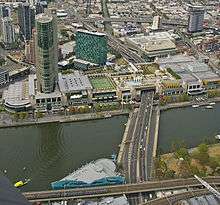King Street Bridge (Melbourne)
| King Street Bridge (Melbourne) | |
|---|---|
 Overlooking the King Street Bridge and Crown Casino and Entertainment Complex | |
| Coordinates | 37°49′19.5″S 144°57′29.0″E / 37.822083°S 144.958056°ECoordinates: 37°49′19.5″S 144°57′29.0″E / 37.822083°S 144.958056°E |
| History | |
| Designer | Utah Australia |
| Opened | April 12, 1961 |
The King Street Bridge takes King Street over the Yarra River in Melbourne, Victoria, Australia. The bridge continues south as an elevated viaduct, with the Crown Casino and Entertainment Complex built around it in later years.
History
The bridge was designed in 1959 by Utah Australia for the Country Roads Board, and constructed over the next two years,[1][2] being opened on 12 April 1961.[3] It was of a welded, deck-girder, suspended-span construction with spans up to 160 feet (49 m) long.
Soon after completion, on 10 July 1962, one span collapsed under the weight of a 47-ton semi-trailer, though the weight was within the bridge limits. The subsequent Royal Commission found the bridge failed with a brittle fracture on a very cold Melbourne winter day. The Commission identified the cause of girder failure as cracked welds that started at welded-on doubler plates which were used to thicken the flange. The Cracks were due to a combination of hydrogen embrittlement and poor design. The doubler plate was welded on all 4 sides which counter-intuitively, greatly reduces the fatigue strength when compared to a 3 sided weld. This could have been prevented by either taking measures to prevent hydrogen embrittlement by taking actions such as pre-heating or by using a 3 sided weld. Also, a thicker flange I beam could have been used.[4][5] The south end of the bridge has been undergoing differential settlement between the approach ramps resting on fill, and the suspended section supported by bored piles.[1][6] The embarrassing incident was widely satirised at the time; most notably by the Melbourne TV clowns Zig and Zag and was the inspiration for a Spike Milligan radio comedy.
The redesign and strengthening of the bridge was undertaken by Melbourne engineer Bruce Day who employed a series of post tension pipes and concrete counter weights.
As originally constructed the bridge had 8 lanes across the Yarra River - 2 through lanes in each direction connecting King Street to Kingsway, in addition to 2 lanes on each side that connected to Yarra Bank Road. At the south end north facing on and off ramps connected to Whiteman Street, and the running lanes from the viaduct descend to ground level, with tram route 58 emerging from City Road to the median strip.[7] In later years the development of Crown Casino closed Yarra Bank Road, and the bridge ramps were connected to the basement carpark of the complex.[8][9]
 Viewed from the west
Viewed from the west The elevated section of Kingsway headed north through the Crown Casino complex
The elevated section of Kingsway headed north through the Crown Casino complex Looking south to the end of the elevated section of Kingsway
Looking south to the end of the elevated section of Kingsway
References
- 1 2 Kellog Brown and Root (November 13, 2006). "King Street Bridge - southern approach and down ramps: Report on possible rehabilitation solutions" (PDF). Retrieved 2008-06-17. (accessed via FoI by Channel 7 news)
- ↑ "TRAFFIC RELIEF PROJECT: £870,000 Bridge for King Street Favored". The Age (31, 070). Victoria, Australia. 1 December 1954. p. 8. Retrieved 23 April 2017 – via National Library of Australia.
- ↑ "In Victoria This Week: That King Street Bridge will be opened officially on April 12". The Canberra Times. 35, (9, 878). Australian Capital Territory, Australia. 5 April 1961. p. 2. Retrieved 23 April 2017 – via National Library of Australia.
- ↑ Report of the Royal Commission into the failure of the Kings Street Bridge (PDF). Melbourne: Government of Victoria. 1963. Retrieved 29 April 2013.
- ↑ "King Street Bridge in Melbourne". iiw-wg5.cv.titech.ac.jp. Archived from the original on 2008-01-30. Retrieved 2008-06-17.
- ↑ Gardiner, Ashley (June 17, 2008). "Melbourne city's Kings Bridge cracking up". Herald Sun. www.news.com.au. Retrieved 2008-06-17.
- ↑ "Melway Edition 1". www.custommaps.net. 1966. Archived from the original on 2007-09-05. Retrieved 2008-06-17.
- ↑ "Melbourne Casino". Architecture Australia. archmedia.com.au. July–August 1997. Retrieved 2008-06-17.
- ↑ Kim Dovey, Leonie Sandercock (2004). Fluid City: Transforming Melbourne's Urban Waterfront. UNSW Press. Retrieved 2008-06-17.